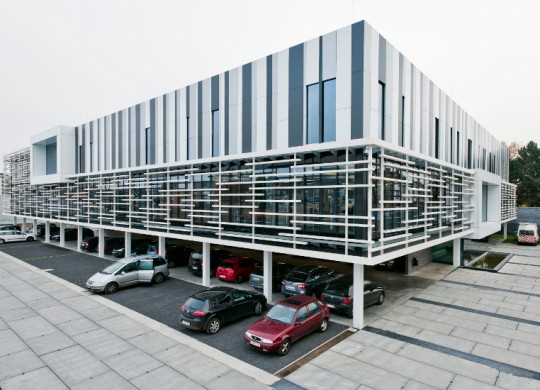Related projects
Infosteel: ‘Head Office of TMVW’
TMVW water-link has constructed a new office building in Ghent. The building has a surface of about 10.000 m² over four building layers and was realized with a steel main support structure. Notable is the use – for the first time in Belgium – of Slimline floors with a spanning of 16.2 m.
signum+ architects, a bureau in Ghent, was engaged to realize the architecture and the concept. The starting point was a global approach in which durability, ecology and economics played an important role. “With limited means and in a smart way trying to use the available building materials to reach a maximum result” is how Architect MScEng Donald Desmet describes the approach. The new building is located centrally on the TMVW site and has four building layers: one subterranean parking level, one ground floor and two office layers.
Energy performance
Very important in the design were the conceptual choices which had a direct impact on the energy performance. The building is one compact block of 42 x 60 m. It was calculated that the compactness determines 15% of the EP-level of buildings. In this case an E-level of 39 was realized, which is an excellent score.
A second important element was insulation. The insulation under the floor slab is 23 cm and on the roof 20 cm. For the windows 1.1 solar control glass was used. Openness and transparency were two other characteristics important to the architects. The building is constructed in 3 modules of 16,20 – 10,80 and 16,20 m and is for the rest column-free, which enables daylight to pour deep into the complete office area and leaves a extreme freedom of design and use. The sunlight is furthermore optimized by the light filtering of the solar control glass and by light management systems via lamellae.
The subterranean level houses a parking lot, some technical rooms, the archives and ICT-facilities.
The building was equipped with a heat pump system – 32 boreholes to a depth of 130 m – which meets 70% of all heating and cooling demands. The E-level of 39 was realized with a compact and modest installation in the concrete slab on the floor and in the ceiling. Other areas are treated by air groups and heat pumps which extract in an active or passive way heat or cold from the ground.
Transparency and flexibility
On the ground floor we find the central entrance with an atrium which catches the light, staircases and a parking lot. Only the narrow module houses reception functions. The atrium provides the vertical connection, light and transparency and fulfils the circulation function. As a consequence all the offices enjoy visual contact and daylight.
Not only transparency but also flexibility was an important characteristic of the design. This flexibility can be found on the first and the second floor where the large spanning is not interrupted by fixed elements. The columns give the principal a large freedom to fill in the landscape. The inner walls can be placed anywhere and the technical installations are completely modular. But this flexibility also has a price. It is not possible to install fixed rooms on the corners.
On the first floor there is a second atrium. The space here is not only used as office space but it also holds movable boxes which can be used for informal consultation. The top floor houses the main conference room and a number of offices. Floor and ceiling heating is provided on both the first and the second floor. The air treatment was installed centrally on the roof.
Floor concept
In this office building the Slimline floor concept was used for the first time in Belgium. ‘One of the starting points was to limit the use of material by looking for a light structure,’ Donald Desmet says. ‘The floor slab consists of wide slab floors with two beams of which the lower zone is activated. The complete structure is acoustically interrupted and all technical installations are easily reachable. The floor is only 72 cm thick and everything is incorporated in it.’ While designing the steel structure and the floor elements the cradle-to-cradle principle – a strategy for product and process innovation which focuses on closed-loop material cycles – was taken into account. By using this type of floor a reduction of 40 cm of volume per floor could be realized. The complete economy for the building is about 1,2 m in height. Since the piping is incorporated in the floor its accessibility in its proper legal space is a lot higher than when it is attached to the ceiling. The application of building component activation – heating and cooling pipes in the concrete floor – and concrete core activation – thermal convenience – are essential in this project.
The company Cordeel got from Slimline Buildings a one-time license for this project. ‘We could count on the know-how and the knowledge centre of Slimline Buildings for the elaboration of the process which is completely new in Belgium,’ project manager Gunther Vandevelde says. ‘It is a self-supporting floor on two supports where the beams span and the loads are transferred to the underlying main support structure. It may look simple but the task was much more complex than expected. Obtaining a one-time license entails risks regarding timing, budget, quality and safety and requires specific attention and measures.’ On the whole 1.000 ton S355 quality steel was used in the TMVW project. Three hundred IPE 600-beams with a span of 16,20 m formed the basis of the structure. Cordeel manufactured the support lips, openings and spiders. The holes were made specifically for the project, after which the rebars were welded to the beams and the concrete core activation was installed. Finally the pre-cast elements were concreted. The creation of the steel structure was concurrent with the manufacturing of the pre-cast elements. As soon as the elements were ready they were fitted as a whole in the steel structure using large hoisting cranes. Not really a piece of cake considering the fact that these slabs of 16,20 by 2,4 m weigh about 12 ton. Because of the strict schedule the columns and the steel skeleton were built up in one piece. The complete operation was successfully completed within the set timing, thanks to an excellent preparation by the study department, the co-ordination with the production department and clever project organization.

